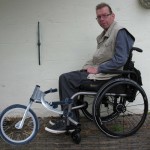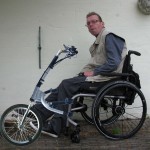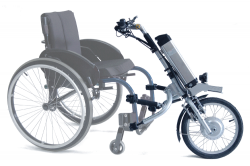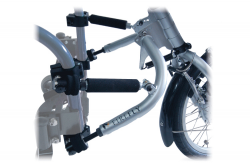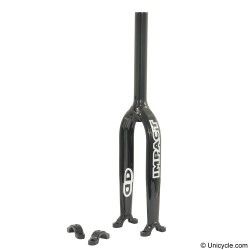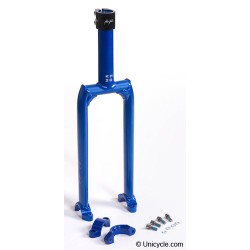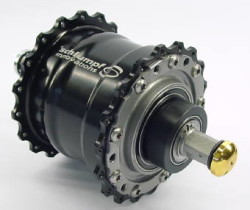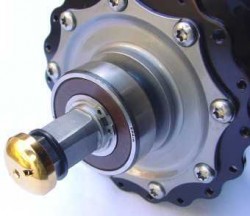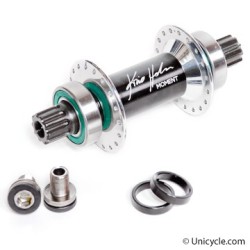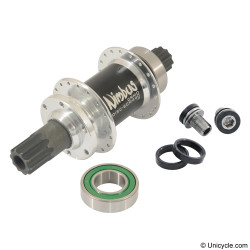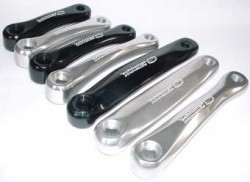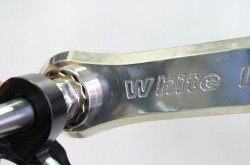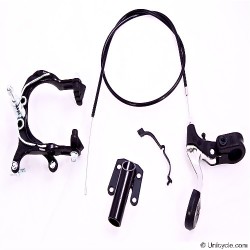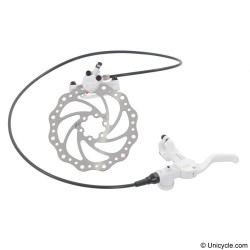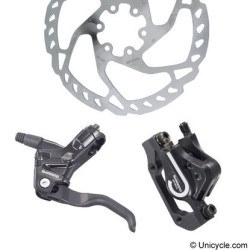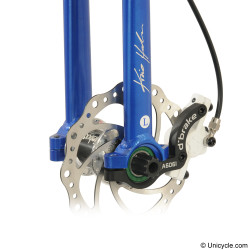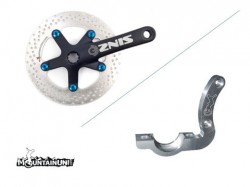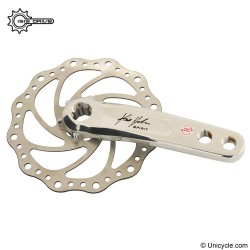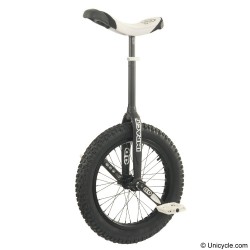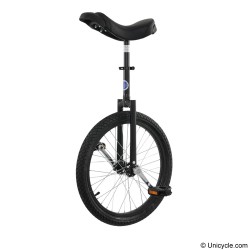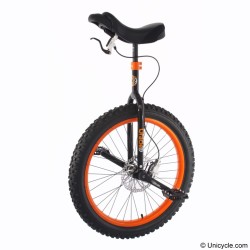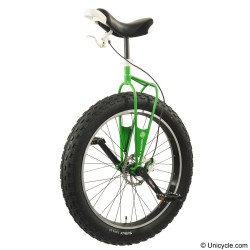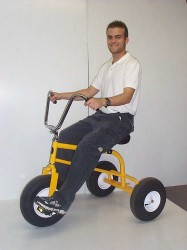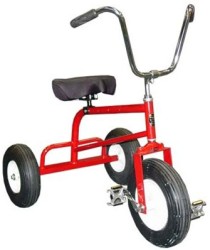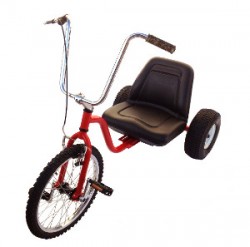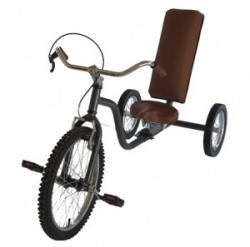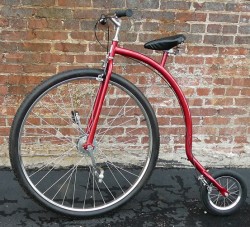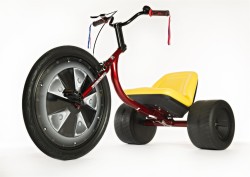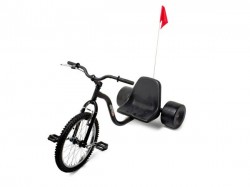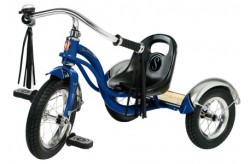Note: This is “thinking out loud” and very rough ideas, basic research, etc. It is not something we are actively pursing now, but I may see what we can do in the future. If we do that, it will be using the adapter that we have used for the Modified All-Terrain Third Wheel with a 12″ wheel with a pedal crank.
Introduction
While I have been looking for All-Terrain Third Wheels, I was thinking that it sure would be nice if there was one that could also be pedaled, like you see on oldstyle trikes. I thought that something like that would be handy if Rob is out and about and does not have the ZX1 Power Add-on attached, or when he did have the ZX1 attached it could be used for handling rough terrain without the pedals on.
Although I know it would not give a lot of propulsion, if it could give some propulsion so he could move at walking speed, and it would save him a lot of work with his arm/shoulder. Also, he really likes to cycle and I thought it would be fun and also be a good way to get some excercise.
I’ve read a few articles about foot propulsion (see links at the bottom), and all seem to suggest that even if someone does not have the full use of both legs it is still easier to propel with your legs than your arms. As someone who use to bicycle a lot, this seems only logical to me, and I think would be useful for many people who have partial paralysis and hemiparesis (one side weakness).
What the Current Idea Is
Here are some very rough (angles are wrong) Photoshopped images of Rob with the Rio Mobility Firefly in normal power mode, and mockups as a third wheel all terrain wheel for use with the ZX1 power-add on, and as a pedal propelled wheel. Of course, all the details will need to be figured out, but this is to give a rough idea of what I am thinking about.
What is Available
Like many things, this seemed like it should be something fairly easy to find, but once again I was very much mistaken. There are exactly 2 foot pedal only products on the market made for wheelchairs. Both are based on full fledged handbikes, without the hand pedals. That means that they are quite substantial equipment and also expensive. Although they would be really nice to have, they are much more than what is needed and will not work as a third wheel when using the ZX1 for power because they are too big (see Handbike and Recumbents)
I was hoping that something simple was available, like an attachable third wheel with a pedal crank, with the possibly for handle bars and brakes. The idea was that it would also work as the FreeWheel does on rough terrain, with the added ability to pedal for excercise when not using the ZX1 for power. Since we really don’t know how much pedaling will be possible, I wanted to see if there was anything relatively cheap out there to try.
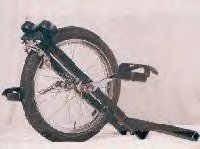 It was while looking into this that I came across a video made by a guy who invented a basic third wheel with a crank pedal. I understand that he is no longer making it, but the basic concept is a lot like I was envisioning. It is no longer in production, but I show it here, because it is the concept of what we are looking for, something simple and not too expensive. Here is a video of it with the inventor, William “Chief” Jacobs, who seems like a nice guy. I even tried to call him. I saw from the YouTube page that he is now in a veteran’s home, and unfortunately, I had no luck there either.
It was while looking into this that I came across a video made by a guy who invented a basic third wheel with a crank pedal. I understand that he is no longer making it, but the basic concept is a lot like I was envisioning. It is no longer in production, but I show it here, because it is the concept of what we are looking for, something simple and not too expensive. Here is a video of it with the inventor, William “Chief” Jacobs, who seems like a nice guy. I even tried to call him. I saw from the YouTube page that he is now in a veteran’s home, and unfortunately, I had no luck there either.
Our Goals and Requirements
There are 2 goals I am trying to accomplish if we find a pedal option for Rob:
- Have an All-Terrain Third Wheel, with similar capabilities as the FreeWheel, in a non-pedaled mode when using a power add-on.
- Have pedal propulsion capability when not using a ZX1 power add-on at walking speed.
I am trying to do this with one piece of wheelchair attachment equipment to avoid having extra adapter mounting hardware, needing to carry multiple pieces of equipment (i.e., when flying), and because of costs. It would have an adapter for mounting to the wheelchair that could be used for both situations. For example, here is a use scenario:
- In all-terrain third wheel mode, a 12-16″ wheel would be used without handle bars, brakes, etc.
- In pedal propulsion mode a 20″ wheel with a pedal crank could be used, with handle bars, brakes, etc.
The benefits of this dual solution is that in all-terrain third wheel mode it would still be maneuverable with a smaller wheel, and in pedal propulsion mode it would be more effective to have some speed with a bigger wheel. I think a disc brake would probably make it easier to manage the mismatched wheel and fork size for the bigger wheel in pedal propulsion mode. Possibly we could even consider a geared hub for the pedal propulsion mode.
In general, here are some of our requirements
- Easy to self ride with one hand in pedal mode, due to hemiparesis, weakaness in one side of the body.
- Ease of use (not complicated) in pedal mode, with all of the instruments and brakes on the right side..
- Easy to self connect/disconnect, in third wheel or pedal mode, with no use of tools.
- Not too heavy of adapter/mounting systems when it is not in use, so that the manual chair is not weighted down.
- It would be nice if we could add a rack, to be used for carrying things, shopping, etc.
Our Requirements Currently are Not
I’ve looked into wheelchair pedal Handbike attachments currently on the market, and they are all large, cumbersome, and in many cases, overkill for what is needed. The handlebars would be in the way if it was used in combination with the ZX1 power add-on, because Rob’s working hand would be on the joystick for the ZX1 power add-on.
At this time we are also not looking for a completely separate piece of equipment to pedal, like a trike or recumbent. Although Rob would really like to bike again, having a separate piece of equipment would probably still be too much for him, and would mean towing a wheelchair. If after getting a pedal attachment and Rob really gets into biking, we would look into a “tri-recumbent”.
Pedal Third Wheel Components
Because I could find nothing on the market, this led me to looking into what might be possible for us making our own Pedal Third Wheel based on parts from unicycles, bicycles, recumbents, trikes, big wheels, drift trikes, etc. Below is information about attachments for fixing it to a wheelchair, along with parts which might work as a basis for making our own pedaled third wheel.
Wheelchair Frame Attachments
The biggest issue (I think) will be finding a way to secure it well onto the chair, so I am looking to see if there are any simple attachment adapters on the market that we might be able to use in this way. I am thinking we could use the attaching system from already existing Power Handbikes or All-Terrain Third Wheels. Some other places to check for attachments/adapters may be KlickFix who make bicycle attachments, TerraCycle Recumbent Bike Parts, and possibly motorcyle mounts.
Here are some examples of some attachment systems that might work:
RioMobility Firefly
Forks / Bearings Holders
In order to work without handlebars in third wheel mode, it would need to be able to be fixed with a spring like the Firefly attachment or would need to spin 360 degrees. The idea would be to use a bicycle fork and modify the dropouts to be like those used on unicycles. I think it would need to be vertical in third wheel mode with a headset that is able to spin 360 degrees. In pedal mode it would need to be angled to the length of Rob’s legs and have a mechanism so that the wheel and headset did not not spin all over the place.
Someone on the Unicyclists community said it would be pretty easy for a bike frame builder to put unicycle bearing holders on an ordinary bike fork, instead of the normal dropouts. Then we wouldn’t need a custom solution for the handlebars or headset, we would just put the unicycle wheel in the bike fork.
Unicycles use main cap bearing holders. The bearing is split and secured between two caps being held together with two vertical screws. The upper cap is welded to the frame.Here is link for information about unicycle bearing holders and some pictures:
I’m not sure what would be the best fork to consider. I’ve looked into folding, BMX, small wheel and travel mountain bikes with 12-20″ wheels. Probably the best known is Brompton but these are also many others. This is not a complete list, but a list those that may have parts and designs that would be useful: Bike Friday (custom), Birdy, Brompton Bicycle, Dahon, KHS Bicycles, Melon Bicycle, Mobiky, Moulton bicycles, Montague Bikes, Pacific Cycles, Tern Bicycles, Gekko Folding Bike. A good website for these are NYCeWheels and also for videos on YouTube.
There are a few travel adjustable suspension forks out there for mountain bikes made by Fox and Sram RockShox. They are very expensive and take some maintenance. In short, overkill for this application, and much too big, made for 26″and 29″ wheels. Here is a good overview for reference Buyer’s guide to suspension forks and Best mountain bike suspension forks.
Hubs
I think a standard unicycle hub with no gears will be the best to start with, though it will be slower than a geared hub. You can get geared unicycles (“GUni”) from Schlumpf and a few other companies. Coker Cycles, maker of unicycles and the Wheelman (Penny Farthing bicycle) also have geared hubs along with Sturmey Archer, Nimbus and some others. The problem with these is finding a way to change gears easily on the fly, and I think it would be too difficult.
Unicycle hubs are designed so the axle is a fixed part of the hub. This means the rotation of the cranks directly controls the rotation of the wheel (direct drive). The frame sits on top of the axle bearings, while the cranks attach to the ends of the axle. Here are some examples:
Cranks and Pedals
For cranks I think we will pretty much stay with what is standard for unicyles. For pedals we can probably choose from may types in the uni- or bicycle industry.
White has a quick release pedal crank that would be good when attaching to the ZX1 for power and not needing the pedals.It would be nice if there was a quick release crank, but I have not found one. Another option is folding pedals, like used on commuter bikes. Here are some examples:
Brakes
While attached with the ZX1 Power Add-on, the ZX1 will control braking. When using it without the ZX1 the speed should not be so fast as to need heavy braking, except if on a ramp or hill. Once stopped, Rob can use the D’s Lock rear wheel lock as a parking brake, and it will be in a more accessible position on the wheelchair.
A standard V-brake system would probably be okay, if it can be mounted on a bigger frame with a smaller wheel size. Another option is having a disc brake, but I would want to make sure it is low maintenance ( I am leery of needing to bleed hydraulic brakes pads a lot). Mountain unicyles which are bigger with 24″, 26″, 28″ and 36″ wheels seem to be the types fitted with disc brakes, which I have been told can also be fitted on a smaller wheel. Disc brakes need a bracket for the frame to hold the calipe,along with a disc brake hub which is hard to find on a smaller frame.It may also be possible to use a bolt on disc brake kit Mountainuni, Nimbus ‘d’brake’ Mount or a Kris Holm ISIS Spirit DH Crank.
Handle bars and Stem
The addition of the steering / handle bars will allow for a brake lever and will give more control and security when not using the ZX1 power add-on. I’m thinking flat (or riser) bars would work well, which are the standard handlebars equipped on mountain bikes, hybrids, and recently on fixed-gear bicycles and flat bar road bikes. A flat bar is a nearly-straight tube, in most cases slightly bent toward the rider and are very light weight.
Formerly mountain and road bars used 25.4mm and 26.0mm (1 inch and 11⁄8 inch) clamp sizes. A more recent standard is a 31.8 mm (1.25″) clamp for both MTB and road bars. 22.2mm is the standard size of BMX bars. The ISO standard for the clamping area of a handlebar is 25.4 mm (1 inch), which is used on mountain bikes. Here is a good link on Handlebar Diameters.
Wheels
Most of the wheels for Third Wheels are 12″ to 20 “. Definitely the bigger the wheel, the better it will handle rough terrain and the faster it will go. On the flip side, the bigger the wheel, the harder it will be to transfer over and maneuver with.
After playing around with a CAD drawing with different sized wheels, I’m thinking that a 16 inch wheel might be the most workable, with a maximum of 18 inch. It’s big enough to get some level of speed, but small enough to be manoeuvrable in smaller places. It is standard size in folding bikes like the Brompton and Dahon and not uncommon in the BMX industry. If we decided to go with a bigger wheel for pedal propulsion, probably a 20” would be a good size.
Links about Pedal and Leg Propulsion
I’m still working on this with proper links and references.
Usefulness of a Leg-pedaled Wheelchair for Hemiplegic Patients
Speed and physiological cost index of hemiplegic patients pedalling a wheelchair with both legs.
Usability Evaluation of Three Unilateral — Propelled Wheelchairs for Hemiplegic Patients
A wheelchair modified for leg propulsion using voluntary activity or electrical stimulation.
Comparison of Energy Costs of Leg-Cycling Wheelchairs With or Without Functional Electrical Stimulation and Manual Wheelchairs for Patients After Stroke
Development of a Pedal Powered Wheelchair
Motion Analysis of Wheelchair Propulsion with the Lower Legs of Normal Persons
There are also a few pedal wheelchairs out there, but they are full wheelchairs, rather than something that can be connected to an existing wheelchair. Neither of these have caught on much, but the pedal concept is good. Here are some videos of pedal powered wheelchairs to give an idea:
Pedal wheel chair from Japan
Pedal wheelchair from www.ped-L-Tech.com.
Unicycles, Trikes, and Other Stuff
These are some other things I looked into that I want to keep for reference.
Unicycles
When I first started looking into this I had thought a unicycle frame might be needed, but no longer think that is necessary, because it would make it more difficult for adding handlebars.
Unicycles frames are presented by wheel size. In Unicycling, street, trial or freestyle frames typically have 20″ wheels, which seems to be about the largest possible size that would work. What seems like a good option is a 20″ Longneck Frame, but if we could get one smaller for a 16″ frame, or use a larger frame with a smaller wheel, that would be much better. I have been told that this is possible.
There are also some 16″ and 18″ unicycle frames made for kids, but the quality does not look as good. I also looked into forks for recumbent, BMX or folding bike forks but none of them will work because of the pedal crank.
The steering / handlebars would need to be mounted where the seatpost is normally mounted. The most common size for unicycle frames diameters for seatposts / seatpost clamps are 22.2mm or 25.4mm but some heavy duty mountain frames are 27.2mm.The mountain frames (“muni” cycle) are bigger with 24″, 26″, 28″ and 36″ wheels.
A good source for unicycle and frames is www.unicycle.com. I’ve been told that in Seattle Gregg’s Cycles is good, but it looks like they mostly only carry Torcker on the website.
These are some options I looked at for coaster (foot) brakes, where the pedals are directly connected to the front wheel like on this Worksman WTX Wide Track Trike.and other adult trikes with front pedal wheels:
The Coker Wheelman (Penny Farthing bicycle) with front pedal wheels:
Here are some pictures of big wheels, drift trikes, and trikes.
